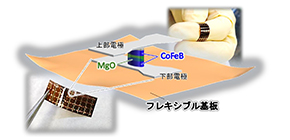
Spintronics devices formed on a flexible substrate can be used as magnetic storage for wearable devices
A group of researchers from Osaka University, The University of Tokyo, and Murata Manufacturing Co., Ltd. demonstrated that CoFeB/MgO/CoFeB magnetic tunnel junctions (MTJs) directly formed on a flexible polyimide substrate had superior ability equivalent to the CoFeB/MgO-based MTJ fabricated (in the same way) on a thermally oxidized silicon substrate.
Spintronics devices are particularly attractive for memory storage and magnetic sensor applications and are important for the Internet of Things (IoT) industry. This group has promoted the development of new industrial applications of spintronics devices formed on flexible substrates. Because of their flexibility, mechanical function for strain sensing can be added to conventional spintronics devices. Unlike conventional spintronics focusing on increasing the speed of magnetic recording technology, new spintronics devices will open a new path for their industrial applications.
The MTJs used in this study, a CoFeB/MgO/CoFeB structure, are widely used for reading heads of hard disks and solid magnetic Random Access Memory (RAM). The researchers developed CoFeB/MgO/CoFeB for MTJs with MgO tunnel barrier layers. While the direction of magnetization of CoFeB multilayers in a magnetic region with high resistance is in antiparallel, the direction in a magnetic region with high resistance is in parallel. Through high-temperature annealing, the tunnel magnetoresistance (TMR) ratio drastically enhances.
In this study, using polyimide substrates, the researchers fabricated devices that could stand up to an annealing temperature of 500℃. The TMR ratio enhanced and reached up to ~ 200% (a three-fold increase of resistance) at an annealing temperature of 450℃, showing that the device on a flexible substrate has the performance of devices formed on a rigid thermally-oxidized Si substrate.
Devices annealed at a high temperature have high thermal tolerance, maintaining device performance under the annealing temperature. In this study, images taken by a scanning transmission electron microscope confirmed the improvement of the crystallization of the CoFeB and MgO layers, which can be an important factor in enhancing the TMR ratio. In experiments, the TMR ratio showed no change during and after a 1000-cycle application of a tensile strain. The newly-developed spin devices demonstrated high strain endurance.
This group’s achievements will lead to the development of spintronics technologies necessary for IoT applications, such as integrated magnetic memory in wearable devices, flexible highly-sensitive magnetic sensors, mechanical sensors using resistance change due to reversible magnetization caused by stretching a substrate, and wearable human motion sensors.

Figure 1

Figure 2

Figure 3

Figure 4
The article, “Flexible CoFeB/MgO-based magnetic tunnel junctions annealed at high temperature (≥350℃),” was published in Applied Physics Letters at DOI: https://doi.org/10.1063/1.5128952 .
Related Links
